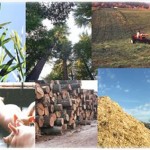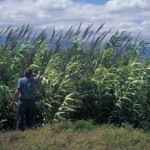Algal Biomass Organization Hails Congress
Legislation Removes a Major Barrier to Commercialization of Algae-Based Biofuels
 WASHINGTON–(BUSINESS WIRE)–The Algal Biomass Organization (ABO), the trade association for the U.S. algae industry, today praised the U.S. House of Representatives for passing H.R. 4168, the Algae-based Renewable Fuel Promotion Act. ABO specifically recognized Reps. Harry Teague (D-NM), Mary Bono Mack (R-CA), Dave Reichert (R-WA) and Brian Bilbray (R-CA) for leading efforts to give algae-based biofuel tax parity with cellulosic biofuels with respect to a $1.01 per gallon production tax credit and a 50 percent bonus depreciation for biofuel plant property.
WASHINGTON–(BUSINESS WIRE)–The Algal Biomass Organization (ABO), the trade association for the U.S. algae industry, today praised the U.S. House of Representatives for passing H.R. 4168, the Algae-based Renewable Fuel Promotion Act. ABO specifically recognized Reps. Harry Teague (D-NM), Mary Bono Mack (R-CA), Dave Reichert (R-WA) and Brian Bilbray (R-CA) for leading efforts to give algae-based biofuel tax parity with cellulosic biofuels with respect to a $1.01 per gallon production tax credit and a 50 percent bonus depreciation for biofuel plant property.
“We’d like to thank the House – and particularly our vocal Democratic and Republican supporters in Congress – for supporting algae and giving our attendees another reason to celebrate and feel great about our industry’s prospects”
“Today, the House sent an unmistakable message of bipartisan support to the hundreds of companies, scientists, entrepreneurs and government agencies working to accelerate the development of algae-based fuels, which will create jobs, decrease emissions and reduce our nation’s dependence on imported fossil fuels,” said Mary Rosenthal, Executive Director of ABO. “The passage of this bill is a huge first step towards our goal of creating parity for algae-based biofuels within the tax code and among various other government programs.”
The timing of the legislation’s passage could not have been better, as Tuesday was the first full day of the 4th Annual Algae Biomass Summit, the official conference and trade show of the Algal Biomass Organization, the largest annual gathering of algae industry leaders in the world. More than 600 attendees have gathered in Phoenix, Arizona for the three-day summit, which features more than 100 speakers, dozens of exhibitors and poster sessions.
“We’d like to thank the House – and particularly our vocal Democratic and Republican supporters in Congress – for supporting algae and giving our attendees another reason to celebrate and feel great about our industry’s
Biomass as a Renewable Energy Resource
 by Rashid Faridi-Biomass is a renewable energy resource derived from the carbonaceous waste of various human and natural activities. It is derived from numerous sources, including the by-products from the timber industry, agricultural crops, raw material from the forest, major parts of household waste and wood.
by Rashid Faridi-Biomass is a renewable energy resource derived from the carbonaceous waste of various human and natural activities. It is derived from numerous sources, including the by-products from the timber industry, agricultural crops, raw material from the forest, major parts of household waste and wood.
Biomass does not add carbon dioxide to the atmosphere as it absorbs the same amount of carbon in growing as it releases when consumed as a fuel. Its advantage is that it can be used to generate electricity with the same equipment or power plants that are now burning fossil fuels. Biomass is an important source of energy and the most important fuel worldwide after coal, oil and natural gas.
Traditional use of biomass is more than its use in modern application. In the developed world biomass is again becoming important for applications such as combined heat and power generation. In addition, biomass energy is gaining significance as a source of clean heat for domestic heating and community heating applications. In fact in countries like Finland, USA and Sweden the per capita biomass energy used is higher than it is in India, China or in Asia.
Biomass fuels used in India account for about one third of the total fuel used in the country, being the most important fuel used in over 90% of the rural households and about 15% of the urban households.
Instead of burning the loose biomass fuel directly, it is more practical to compress it into briquettes (compressing them through a process to form blocks of different shapes) and thereby improve its utility and convenience of use. Such biomass in the dense briquetted form can either be used directly as fuel instead of coal in the traditional chulhas and furnaces or in the gasifier. Gasifier converts solid fuel into a more convenient-to-use gaseous form of fuel called producer gas.
Scientists are trying to explore the advantages of biomass energy as an alternative energy source as it is renewable and free from net CO2 (carbon dioxide) emissions, and is abundantly available on earth in the form of agricultural residue, city garbage, cattle dung, firewood, etc. Bio-energy, in the form of biogas, which is derived from biomass, is expected to become one of the key energy resources for global sustainable development.
At present, biogas technology provides an alternative source of energy in rural India for cooking. It is particularly useful for village households that have their own cattle. Through a simple process cattle dung is used to produce a gas, which serves as fuel for cooking. The residual dung is used as manure.
Biogas plants have been set up in many areas and are becoming very popular. Using local resources, namely cattle waste and other organic wastes, energy and manure are derived. A mini biogas digester has recently been designed and developed, and is being in-field tested for domestic lighting.
Indian sugar mills are rapidly turning to bagasse, the leftover of cane after it is crushed and its juice extracted, to generate electricity. This is mainly being done to clean up the environment, cut down power costs and earn additional revenue. According to current estimates, about 3500 MW of power can be generated from bagasse in the existing 430 sugar mills in the country. Around 270 MW of power has already been commissioned and more is under construction.
Chinese firm looks into 10MW biomass project in Nevada
 By James Cartledge- Brighter Energy-Lincoln County in Nevada has teamed up with Chinese energy systems manufacturer A-Power to investigate the potential to build a 10-megawatt biomass power plant in the area.
By James Cartledge- Brighter Energy-Lincoln County in Nevada has teamed up with Chinese energy systems manufacturer A-Power to investigate the potential to build a 10-megawatt biomass power plant in the area.
The new partners will conduct a joint feasibility study looking at building and operating a possible facility to generate electricity from local landscaping projects carried out by the federal Bureau of Land Management.
In particular, the Bureau has identified more than a million acres of Pinyon-Juniper woodland in Lincoln County that requires a clear out to cut the threat of catastrophic wildfires.
The sparsely-populated county in the south-east of Nevada has been looking for industrial users of Pinyon-Juniper biomass for some time.
A-Power Energy Generation Systems chief operating officer John Lin has said the Pinyon-Juniper biomass project could help his company gain international exposure for its distributed generation business.
The project also has the support of Nevada Senator and Senate Majority Leader Harry Reid.
Senator Reid said: “I congratulate Lincoln County and A-Power for their partnership. The commitment of the county and the company to invest in clean energy development is important to the recovery of the local and state economy.
“It is my hope this study will lead to permanent, good-paying jobs for the residents of Lincoln County,” added Sen. Reid.
Lincoln County and A-Power anticipate completing the feasibility study in early 2011.
Lockheed Martin Wins $15 Million Biomass Deal
Posted by Camille Tuutti
Lockheed Martin and Whiting Turner have won a $15 million contract from Department of Veterans Affairs to install a biomass steam-generation system to produce heat and power.
The VA Medical Center in Canandaigua, N.Y., will be outfitted with a fully automated system that uses biomass byproducts–such as wood chips and bark–to generate clean, steam-powered energy.
Lockheed Martin opened its own biomass facility in 2008 as part of the its “Go Green” initiative. By switching from fuel oil to wood chips, the project has reduced the plant’s heating and cooling bills by half and reduced its carbon footprint by 25 percent.
“We recognize the critical need to reduce the country’s dependency on fossil fuels and significantly increase clean energy generation,” said Chris Myers, Lockheed Martin vice president for energy and government programs. “The success of our biomass system demonstrates our ability to design cost efficient, renewable energy systems, helping to secure a clean energy future.”
Lockheed Martin will build, install and test the equipment as well as train VA on how to maintain the biomass system. Whiting Turner will provide onsite construction leadership and work with VA to integrate the biomass system.
How is Biomass Fuel Used to Generate Heat and Power?
 Energy prices for the last decade have been on the rise. There are two main factors driving the increase in prices. Firstly limits of supply of the fossil fuel resources cause many issues, and the constantly growing global demand, particularly from rapidly developing countries such as India and China. The other driving factor is the effect of burning fossil fuels on the environment. Soon due to commitments to reduce carbon emissions, various green taxes are going to be placed on fossil fuels. These green taxes are designed to generate funds for green energy projects, while also directing people to use less energy.
Energy prices for the last decade have been on the rise. There are two main factors driving the increase in prices. Firstly limits of supply of the fossil fuel resources cause many issues, and the constantly growing global demand, particularly from rapidly developing countries such as India and China. The other driving factor is the effect of burning fossil fuels on the environment. Soon due to commitments to reduce carbon emissions, various green taxes are going to be placed on fossil fuels. These green taxes are designed to generate funds for green energy projects, while also directing people to use less energy.
Biomass is one of the renewable energy options to reduce our dependence on oil and other fossil fuels. Biomass refers to a wide range of organic materials, which potentially can be used as a fuel source. The common interpretation of this is wood, however that is a small part of the biomass fuel potential, other much more abundant materials of straws and grasses can also be used.
Different biomass fuels, do burn differently however. Generally each biomass in a compressed form has a similar heat value, however changes in ash content and corrosive effects can generate issues in some biomass burners.
So how can we use biomass, because burning logs simply isn’t a modern solution? Well the answer is in compression, into either pellets or briquettes. In a compressed form the fuel will burn much more efficiently, and its generate a much more practical way to transport and feed fuels. With a uniform compressed material, for example into a pellet, its possible to use the fuel in automated combustion systems such as pellet stoves and boilers.
These automated combustion systems are the 21st century adaptation of the basic log stove to heat your home or business. The fuel can also be used to power homes and business with solutions such as the modern heat engines, which are based on steam engines.
Learn more about how biomass is used. Also, learn about the different types of biomass energy.
Advantages of Biomass As a Source of Energy
As the future and impact of traditional fuels like petroleum and coal come into question biomass is getting more attention as an alternative source of energy. Biomass is simply any material that is formed by living things. Plants, animals, fungus, micro organisms and even you are biomass. When people talk about biomass they are usually talking about biomass that can be used as a source of energy which is called biofuel.
Fossil fuels like coal and petroleum are believed to be the remains of ancient plants and animals so they are biomass too but when people talk about biomass they are usually referring to material that comes from living things today. The major advantage of biomass is that it is renewable and considered carbon neural. Unlike fossil fuels biomass is part of the current natural carbon cycle so there is no long term net increase in carbon in the atmosphere when biofuels are burned.
Many biofuels can be produced from waste materials that come from producing other agricultural and forest products. In this case energy is being utilized that would otherwise have gone to waste. It’s a domestic source of energy that is less influenced by political instability and world events. Using biofuel supports local economies.
Unfortunately biofuels haven’t been cost competitive with most other sources of energy. So far as a fuel for cars or for generating electricity the cost and energy loss from converting biomass into other forms of fuel and energy are too great. Advances in technology could make it more practical in the future but so far we aren’t there yet.
There is an exception to this and that is using biomass for direct heating. People have been heating by burning biomass like wood for thousands of years. This old technology may still be proving to be the most efficient way to utilize biomass energy.
Traditional wood heat may not be practical for most people but wood and other biomass pellets are a practical alternative. Pellet stoves are becoming more popular and are almost as convenient and clean burning as traditional heating systems. For people who want to use biomass for energy they can do so today by switching to pellets for home heating.
Learn more about pellet burning stoves and learn about making wood pellets.
PGE tests biomass process for Boardman
by Lee van der Voo Sustainable Business Oregon
Portland General Electric has teamed with researchers from Washington and Oregon to study how a fast-growing grass could serve as fuel for the utility’s controversial coal-fired power plant in Boardman, if the plant were converted to biomass. It’s one of a handful of possibilities facing the 585-megawatt capacity plant, which burns 2.5 million tons of coal annually and produces enough electricity to power 250,000 homes. The plant is responsible for 15 percent of power production for customers of PGE, but has been under fire for pollution. The Oregon Department of Environmental Quality is poised to mandate new emission controls at the plant, but PGE is aiming to reduce the cost of compliance — and future uncertainty about the cost of carbon regulation related to coal burning — by closing the plant or converting it to other uses over the next 10 to 30 years.
Arundo donax
Even while PGE and the DEQ are sniping over the details of the plan to stop burning coal at Boardman, officials from PGE are working closely with scientists at Oregon and Washington state universities grow test crops of a fast-growing cane grass called Arundo Donax which could meet future fuel needs for a biomass plant. Jaisen Mody, a general manager of generation projects at PGE, unveiled elements of the research during a talk Monday at the second annual conference of Oregon BEST (Oregon Built Environment & Sustainable Technologies Center), a state-funded initiative aimed at spurring economic growth in renewable energy and green building sectors. Speaking to approximately 100 researchers, government employees, students and nonprofit personnel, Mody disclosed that PGE has been working with scientists to grow sample crops of Arundo Donax. The goal is to study its viability as a fuel source and probe how much electricity the grass could produce if it were torrified — or roasted like coffee — into a charcoal-like substance that would burn inside a revamped Boardman plant.
Arundo Donax grows rapidly, as much as one foot per week. It can be harvested twice each growing season and requires approximately the same amounts of water and fertilizer that are used on alfalfa crops, Mody said. Converting the Boardman power plant to burn torrified Arundo Donax would create the first 100-percent torrified biomass power plant in the world. It would require significant changes to the existing plant, Mody said, including a $200 million investment in emission controls.
He said it was too soon to say whether biomass would prove financially viable but general analysis shows it appears to compare favorably to a natural gas combustion turbine or a wind plant with a natural gas “chaser” to fill gaps in production.
Burning biomass at Boardman would also allow the power plant to remain a baseload plant, he said, meaning that it could still provide a constant and dependable power supply without coal, unlike wind or solar farms. “The fact that Boardman has land, sunlight and water makes this a doable solution,” said Mody.
Biomass is far from a done deal, however. Still required is another 10 years of study of whether Arundo Donax could supply the steady stream of fuel a biomass power plant would require, and whether torrified biomass would burn as predicted.
Boardman
PGE has done enough study of the idea, however, to know that converting the Boardman plant to torrified biomass would cost between $350 and $450 million, in addition to the $200 million for pollution controls. Also known is that the utility would need between 75,000 to 114,000 acres to grow Arundo Donax in the Boardman area and that the land could be available without displacing food crops.
Mody said the utility would likely need an additional 60 workers to staff a biomass plant (the Boardman plant currently employs 110 workers year-round and another 225 seasonally). Approximately 400 trucks may also be required to deliver crops, though rail is also being considered.
Portland General Electric spokesman Steve Corson said it’s too soon to say whether biomass will pull ahead of other options still being considered to replace capacity for power generation at the Boardman plant, including additional wind and solar development.
“We really have not begun the process of fully evaluating potential replacements,” he said, adding the utility is still actively involved in clarifying near-term rules for operating the Boardman plant as a coal-fired facility.
In the interim, however, Corson said, PGE has “a responsibility to explore all of the technologies that could be used.”
Those possibilities include renewable energy in part because the state of Oregon is requiring utilities to derive 20 percent of electricity from renewable sources by 2020, and 25 percent by 2025.
Should the biomass idea pull ahead, the idea would face scrutiny from the Oregon Public Utility Commission. The commission is tasked with pushing utilities to generate power through the most affordable means and in ways that pose the least risk to ratepayers.

